Jonah Sacks
Director, Architectural Acoustics Group
Studio A | Market Co-Leader
Principal
As you might guess, Acentech is full of lovers of music and theater, and many a Monday morning conversation in the office kitchen recaps, praises, and critiques the weekend’s shows. Along with who played what and at what venue, we want to know where did you sit?
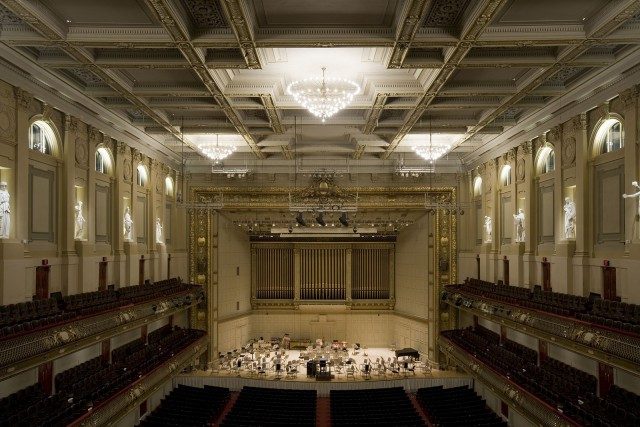
I’ll never forget one particular Boston Symphony Orchestra (BSO) concert as I was still getting to know Symphony Hall. I had developed a fondness for sitting in the last row of the second balcony, mainly based on performances of large orchestral works such as Mahler symphonies. The sound is very nicely blended and surrounding up there, at least for these large works. But, on this night, I was very excited to hear the new Flute Concerto by the venerable but (at that time) still active Elliott Carter. Carter’s music contains many quick, sharp gestures, with plenty of spaces in between. If Mahler’s orchestral music epitomizes density, Carter’s does the same for sparseness. To my disappointment, I found that, from my faraway seat, I missed much of the detail in the music, which was delicate and elusive even for Carter. I made an impromptu return visit the next night to see it again, this time from much closer, and it was wonderful to hear all of the notes and textures and to see the facial and body language of the soloist, Elizabeth Rowe. Since then, I always consider the specific musical program when choosing my seat.
I asked a number of my colleagues to share their thoughts on the topic.
Bob Berens:
My comments are specifically targeted towards classical / symphonic performances, but generally apply to just about any kind of musical performance I can imagine. I’m a big fan of being able to see what’s going on on-stage – who’s playing, facial expressions, and so forth. So, in addition to being able to hear well, I also like to sit where there’s a good view of the stage. Acoustically, I like a balanced sound – generally preferring sitting along, or not far off, the centerline of the venue, and far enough back not to be overwhelmed by direct sound, but not so far back that I lose the full envelopment the house acoustics can provide (including sounds coming off the ceiling); that said, I also prefer a seat in an elevated position – above stage height so I can see who’s playing in the back rows. Sitting on the floor in many venues, I get the sense of listening to a record edge-on – I see the first-row violas playing, but I hear the trumpets along that sight-line. I want a 3D visual experience as well as a 3D aural one.
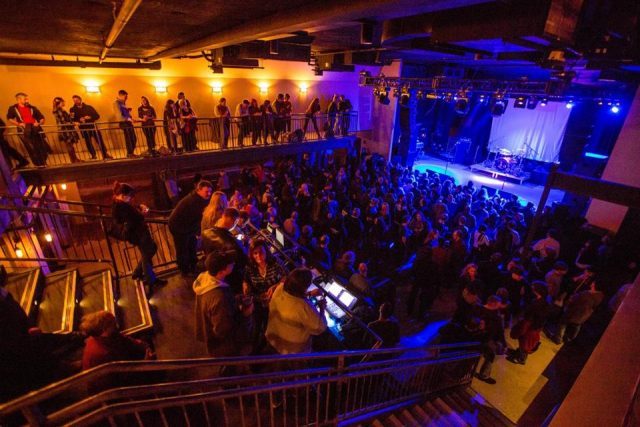
A concert at The Sinclair in Harvard Square, Cambridge, MA.
Ryan Edwards:
I try to get to a place in the middle of the hall where I can see everything well. For a rock show, I’ll try not to be near a large stack of loudspeakers, so my ears don’t get blown out.
Aaron Betit:
I regularly attend opera at the Dorothy Chandler in LA, which is more of a multi-purpose space than ideal for opera. For this reason I sit fairly close. I also never sit in the balconies because it exposes me too much to the orchestra which in turn drowns out the vocal. For this reason I tend to sit on the first level and as close as I can afford.
Carl Rosenberg:
For chamber music, I like to be in the front half of the hall to maximize the direct sound I receive and to see facial expressions and communication between performers.
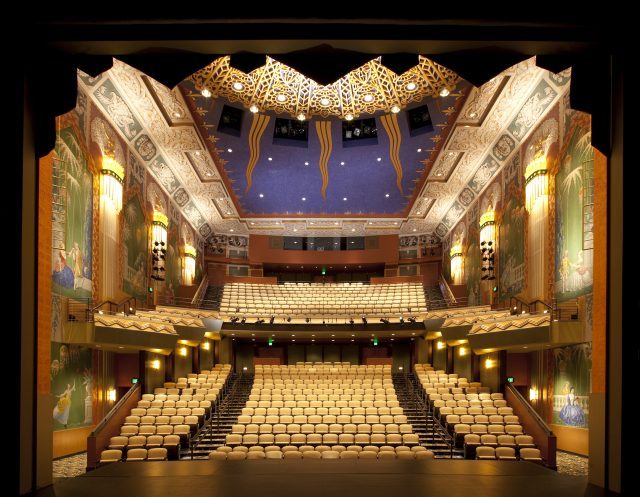
A view from the stage of the Paramount Center in Boston, MA.
John Lloyd:
When I’m attending large orchestral performances at dedicated concert halls, I try to sit near the middle of the room from left to right and avoid being under a balcony or too close to the stage. At this point in my concert-going career I’m still typically at the mercy of rush tickets, so whichever remaining seats best satisfy those qualities are where I end up. If there are open seats near the front of a lower balcony, I could go for those too.
For non-orchestral music, it also depends a great deal on the venue. If it’s a large general admission show at a rock venue I’ll move forward until I am satisfied with the view and comfortable with the amount of elbow room I have and then go no further, since the quality of what I hear is marginally affected when everything is being pumped out through loudspeaker arrays.
Nicole Cuff:
I like to go to singer-songwriter performances, and I’m used to seeing shows in rooms with less than optimal acoustics, so I generally pick my seat based on visuals. I generally sit somewhere between 1/3rds and 1/2 the length of the room away from the performer.
At Boston Symphony Hall, I usually sit in the first balcony.
Matt Azevedo:
For amplified concerts, I’m much more concerned about sight lines than anything else. Worst case, if the PA is junk, I stand right at the stage to hear the drums and amps directly.
For acoustic concerts, somewhere between 10% and 30% off-center, distance proportional to ensemble size. So, for the BSO I like the first balcony near the rail in the rear section. For a solo instrument I’ll sit as close as is polite. Also, for orchestras I usually like to sit so the low strings are pointed at me – this typically means I’ll sit on the violin side.
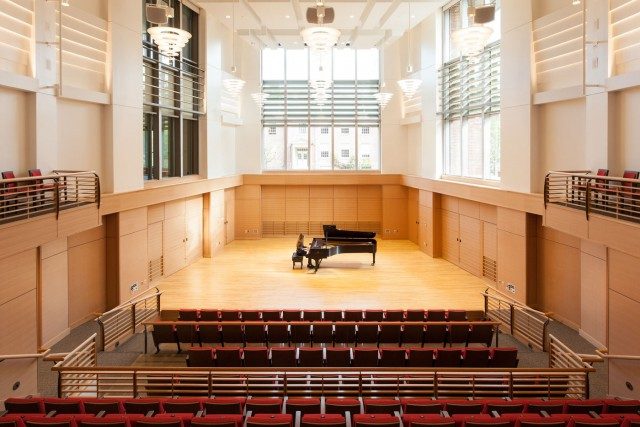
Deerfield Academy’s Hess Center for the Arts in Deerfield, MA.
Kelsey Hochgraf:
I choose where to sit based on what music is being played (orchestral work vs. concerto featuring a soloist vs. all solo/small ensemble, compositional style), and how much I care (i.e. $ I am willing to spend) about the concert (including the music being played, and especially the soloists). After sitting deep under the second balcony for several BSO concerts last year, I try very hard to avoid sitting in this location (at any venue), since it feels & sounds like viewing/listening to the concert through a window.
I recently really enjoyed listening to Yo-Yo Ma with the BSO from roughly the center of the orchestra section because the position provided high intimacy and proximity due to its closeness to the stage, but also great envelopment (lots of energy from all directions – very immersive for The Planets). I also loved listening to Cameron Carpenter on the organ from the back of the second balcony – especially for Barber’s Toccata Festiva and for the orchestra’s rendition of Elgar’s Enigma Variations, but less so for Terry Riley’s contemporary organ piece that required more focused listening. It’s fun to listen to the organ from the orchestra section because you can really feel your seat shake, but sometimes I find the loudness in that area to be overwhelming.
Ethan Brush:
For jazz or rock shows, being able to see the performers is just as important to me as how they sound. I generally like to be close in, but far enough away so that I can see all of the performers without having to turn my head. That way I can pick up some of the little things that happen during the show that you might not see from farther back, like the performers glancing at one another with approval during an improvised section.
Corey Salvatore:
I go to a lot of rock shows, and generally, I try to find somewhere to stand that has decent sightlines to the stage, but isn’t too close. I prefer to be able to see the whole band, but from not too far away. Also, when possible, I try to make sure that place is also one where the sound will be good. Under ideal conditions, this is near the front-of-house mix engineer’s position, because obviously that is where the sound will be best. Assuming of course the engineer knows what they’re doing. One example is the House of Blues in Boston, standing on the ledge right behind the booth. It’s a bit far, but sounds great and is easy to see from.
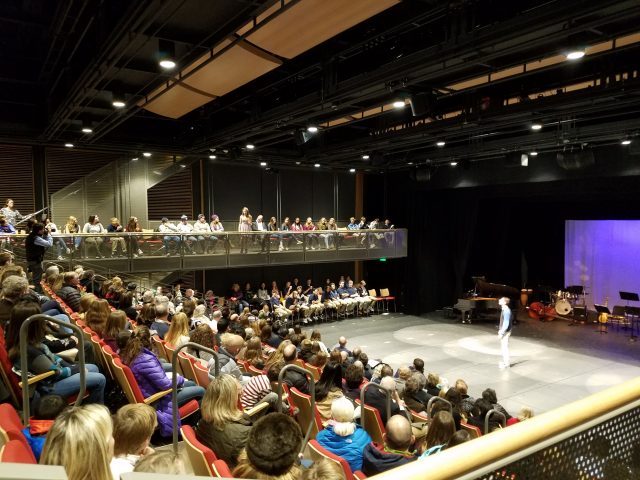
Opening night at the Woodman Family Community & Performance Center at the Moses Brown School in Providence, RI.
Jeff Zapfe:
For me it’s all about being close. Certainly for plays, but for music too. I find I enjoy the performance more if I can see the performers’ facial expressions, hand movements etc. I may not always appreciate the acoustical subtleties, but I love to get the whole visual and sensory experience.
Ben Markham:
For plays and musicals, it’s hard to beat the first row of the balcony (aka “mezzanine” or “dress circle”) in most theaters. Sight lines – which are important for hearing as well as seeing – are usually excellent. The front of the balcony is nearer to the ceiling than is the orchestra level, meaning that sound reflections from the ceiling plane are strong – often an asset for unamplified speech (or song) coming from stage. The front of the balcony is often situated more or less in the middle of the audience chamber volume, out from under the sometimes stifling overhang of upper balconies – this “out in the open” position assures the patron that her sense of space – acoustically and visually – is well grounded. Fellow theatergoers are almost always visible at the periphery of the field of view from those seats, heightening the sense of shared experience – and applause, from all around, is thunderous and fully enveloping. And in my favorite theaters – the not too big ones – the distance from the first row of the balcony to the performer is close enough to preserve a level of intimacy worthy of great performances – that connection between actor and audience that makes for an enthralling theatrical experience.
[I have similar preferences for opera. –JS]
Rose Mary Su:
If I am attending a concert for Mozart or other classical or earlier period music, I like to sit on the first balcony center at Symphony Hall in Boston. It is visually closer to stage, and acoustically the direct sound is stronger and provides more clarity. Some more contemporary music that are more subtle such as Carter requires more clarity as well and I like to sit on the first balcony also if I can.
For Baroque music in Jordan Hall, I like to sit at the orchestra level, not under the balcony. I find it too muddy up on the balcony in that hall.
If it is Romantic era music, anything with a large orchestra, organ performances, etc. I like to sit on second balcony center in Symphony Hall. At this location, I sense more spaciousness and envelopment from the hall, which I find important for that music era.
In a more intimate setting such as the Shalin Liu Center in Rockport, MA, I like sitting at the first row of the balcony level if I can manage to get these seats.
For rock concerts, I like to be close to the front (first few rows) because I would like to see them more than hear them. Spitting distance. Despite the fact that loudspeaker coverage at the very front is not typically the best.